The article outlines some of the main changes in the Slovenian border regime in the past few years. The main change was a stop to the systematic practice of pushbacks on its southern border, which led to one of the biggest recorded numbers of irregular crossings since the closure of the Balkan Corridor in 2015. This also led to an emphasis on surrogate borders in the form of militarising the border through surveillance technology and the adamant perseverance of administrative obstacles in not enabling possibilities for legalisation. Even though the suspension of systematic pushbacks relocated some contradictions of the border regime inwards which was primarily noticeable in the overcrowding of asylum camps and failure to provide conditions for fundamental rights of asylum seekers, the Slovenian border regime remains entangled in its impermeable fortress. The article follows some changes in Slovenian border politics through three aspects: 1.) outline of irregular crossings since 2014 and permutations of the border regime on the border itself, 2.) Slovenia as a transit country and situation of asylum camps and 3.) militarisation of the Slovenian border through surveillance technology.




